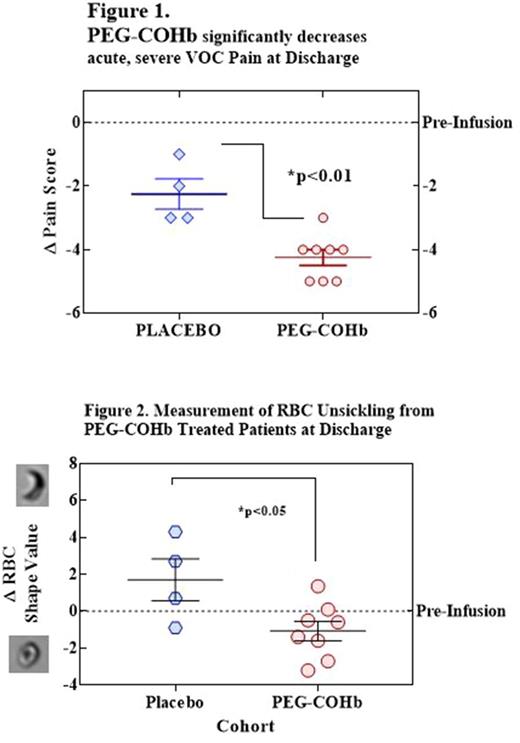Abstract

Background: Pain during Vaso-Occlusive Crisis (VOC) is a hallmark of sickle cell disease (SCD) as deoxygenated (sickled) red blood cells (RBC) aggregate in the microvasculature due to Hemoglobin S (HbS) polymerization. PEGylated carboxyhemoglobin bovine (PEG-COHb; SANGUINATE®) was designed as a gas transfer agent to depolymerize HbS resulting from hypoxia. Prior in vitro studies have shown PEG-COHb capability to transfer carbon monoxide (CO) and oxygen (O2) to SCD hypoxic RBCs, reversing sickling. A prospective, randomized, single-dose Phase II clinical study is in progress (NCT02411708) evaluating the safety and efficacy of PEG-COHb in the treatment of severe VOC including pain reduction in the ambulatory setting. This study is also evaluating the levels of RBC sickling following treatment and association with pain scoring.
Methods: Participants were randomized to a PEG-COHb (320 mg/kg) or saline (placebo) arm, in addition to standard treatment and IV opioid per institutional practice. Pain was assessed using a 10-point pain scale at screening, pre-infusion, hourly until discharge, 24-hours, 72-hours, and Day 7 post-infusion. Blood was collected at pre-infusion, time for readiness to discharge and 72 hours post-infusion to assess RBC shape morphology changes using image-based flow cytometry.
Results: Interim results showed PEG-COHb treated subjects experienced significant reduction at discharge in pain score of 4.3 (±0.3) compared to 2.4 (±0.6) reduction in the placebo arm (p<0.01) (Fig 1). All PEG-COHb participants exhibited RBC morphology changes consistent with unsickling shortly after administration (Fig 2). There were no drug-related severe adverse events.
Conclusions: PEG-COHb appeared to be safe, well tolerated, and associated with significantly reduced pain scores. The flow cytometry analysis of blood samples revealed PEG-COHb treatment reverted RBC to a more normal round morphology when compared to the placebo group. Individual patient data showed a trend between RBC unsickling (roundness) and pain score reductions. These results are consistent with depolymerization of HbS resulting from transfer of CO and/or O2 to sickled RBCs and O2 delivery to hypoxic tissue. This study supports advanced clinical trials of PEG-COHb as a potential therapy to reduce the pain associated with VOC.
Buontempo: Prolong Pharmaceuticals: Employment. Jubin: Prolong Pharmaceuticals: Employment. Buontempo: Prolong Pharmaceuticals: Employment. Real: Prolong Pharmaceuticals: Employment. Kazo: Prolong Pharmaceuticals: Employment. O'Brien: Prolong Pharmaceuticals: Employment. Adeel: Prolong Pharmaceuticals: Employment. Abuchowski: Prolong Pharmaceuticals: Employment, Membership on an entity's Board of Directors or advisory committees.
Author notes
Asterisk with author names denotes non-ASH members.

This icon denotes a clinically relevant abstract


This feature is available to Subscribers Only
Sign In or Create an Account Close Modal